Esha Yadav1*, Rudrakshi Chickanna2, Prabhuji MLV3
1- Post graduate resident, Department of Periodontics and Implantology, Krishnadevaraya College of Dental Sciences and Hospital, Bangalore, Karnataka, India
2- Reader, Department of Periodontics and Implantology, Krishnadevaraya College of Dental Sciences and Hospital, Bangalore, Karnataka, India
3- Head of the Department, Department of Periodontics and Implantology, Krishnadevaraya College of Dental Sciences and Hospital, Bangalore, Karnataka, India
*Corresponding Author: Esha Yadav, Post graduate resident, Department of Periodontics and Implantology, Krishnadevaraya College of Dental Sciences and Hospital, Bangalore, Karnataka, India; Tel: 9148995905; Email: [email protected]
Published Date: 20-06-2020
Copyright© 2020 by Yadav E, et al. All rights reserved. This is an open access article distributed under the terms of the Creative Commons Attribution License, which permits unrestricted use, distribution, and reproduction in any medium, provided the original author and source are credited.
Abstract
Aim: To assess the histological findings on gingiva of smokers and non-smokers who are type II diabetics diagnosed with chronic periodontitis.
Materials and methods: Between the age Group of 30-60 years, patients diagnosed with chronic periodontitis were classified into two Groups. The Group I included ten smoker diabetic patients suffering from chronic periodontitis while Group II included ten non-smoker and diabetic patients with the history of chronic periodontitis.
Results: Diabetic patient’s demonstrated sub epithelial connective tissue lysis, breakdown of collagen fiber bundles. While smokers showed increased epithelial dysplasia and were statistically significant.
Conclusion: Smoking and type II diabetes were significantly associated with Periodontitis. It is suggested that smoking cessation and control of diabetes should be instigated as a vital component of periodontal therapy.
Keywords
Smoking; Gingiva; Chronic Periodontitis; Diabetes
Introduction
Periodontitis is an inflammation of periodontium and is the most common disease (Guinness World Records 2001) [1]. It is prevalent both in developed and developing countries and 20-50% of global population are found to be affected [2]. Studies by Loe reported periodontitis as the sixth complication of diabetes mellitus [3]. Periodontal disease are two to twenty times more prevalent in Smokers (S) than Non-smokers (NS) [4,5]. According to Dhir et al., one unit increase in HbA1c can increase the odds ratio by 1.34 in periodontitis patient [6].
Therefore, our study was undertaken to elaborate the histological effect of smoking on the periodontium of a smoker or a non-smoker diabetic patient.
Materials and methods
A total of twenty patients aged between 32-39 years diagnosed of Chronic Periodontitis (CP) with a probing depth ≥ 5 mm and CAL ≥ 3 mm in at least 6 teeth with a history of Diabetes Mellitus (DM) for at least 10 years with HBA1C ≥ 7% and were on medication were divided into two Groups (Table 1).
Inclusion Criteria: Gingival inflammation, bleeding on probing, recession, deep pockets, mobility or loss of tooth.
Exclusion Criteria: Former smokers, drug induced enlargements, pregnancy and other systemic diseases like hypertension and thyroid problems.
The experimental study Group consisted of twenty diabetic patients of both the sexes aged between 32-39 years, with signs of established periodontal disease, who addressed to the department of periodontology of Krishnadevaraya dental college, Bengaluru for dental problems. Group I- Among 10 diabetic subjects with periodontitis, who had smoked an average of 15 or more cigarettes per day for 10 year were considered smokers (DM+S+CP) and in Group II- Ten diabetic non-smoker subjects with periodontitis (DM+NS+CP).

Table 1: Consort flowchart showing the, Eligibility assessment, randomization and sample collection.
Histological Method
One intraoral site per patient was selected and tissue samples consisted of soft tissues of size 4-5 mm harvested from gingiva acquired during periodontal surgery. In the solutions comprising 10% buffered phosphate formaldehyde with the pH of 7.4. The samples were fixed and embedded in paraffin and sectioned at 5 µm. Later hematoxylin and eosin stain were used to stain the slides. Microscopic examination under light microscope at 10x and 4x magnification was done with Masson’s trichrome method. Histologic assessment was conducted in the department of oral pathology in Krishnadevaraya dental college, Bengaluru.
Statistical Analysis
Statistical analysis was performed using the Statistical Package for Social Science (SPSS version 22.0). Chi square test was used to compare the epithelial and connective tissue findings between Group 1 and 2. The p values <0.001 was considered statistically significant (Table 2 and 3).
|
Comparison of epithelial findings between Group 1 and Group 2 using Chi square Test |
|||||||
|
Variables |
Category |
Group 1 |
Group 2 |
c2 Value |
P-Value |
||
|
N |
% |
n |
% |
||||
|
Epithelial atrophy |
Yes |
10 |
62.50% |
13 |
72.20% |
0.366 |
0.54 |
|
No |
6 |
37.50% |
5 |
27.80% |
|||
|
Increased epithelial basal thickness |
Normal |
2 |
12.50% |
1 |
5.60% |
0.572 |
0.75 |
|
Mild |
12 |
75.00% |
14 |
77.80% |
|||
|
Moderate |
2 |
12.50% |
3 |
16.70% |
|||
|
Epithelial dysplasia |
Yes |
6 |
37.50% |
0 |
0.00% |
8.196 |
0.004* |
|
No |
10 |
62.50% |
18 |
100.00% |
|||
|
Proliferation of keratinocyte |
Yes |
10 |
62.50% |
14 |
77.80% |
0.952 |
0.33 |
|
No |
6 |
37.50% |
4 |
22.20% |
|||
|
Juxta epithelial hyalinization |
Yes |
9 |
56.30% |
10 |
55.60% |
0.002 |
0.97 |
|
No |
7 |
43.80% |
8 |
44.40% |
|||
|
Bulbous rete pegs |
Yes |
15 |
93.80% |
14 |
77.80% |
1.723 |
0.19 |
|
No |
1 |
6.30% |
4 |
22.20% |
|||
|
Acanthosis in stratum spinosum |
Present |
13 |
81.30% |
16 |
88.90% |
0.394 |
0.53 |
|
Absent |
3 |
18.80% |
2 |
11.10% |
|||
|
Keratosis |
Present |
13 |
81.30% |
17 |
94.40% |
1.421 |
0.23 |
|
Absent |
3 |
18.80% |
1 |
5.60% |
|||
Table 2: Comparison of epithelial findings between Group 1 and Group 2. *- (P<0.001) statistically significant.
|
Comparison of Connective Tissue findings between Group 1 and Group 2 using Chi square Test |
|||||||
|
Variables |
Category |
Group 1 |
Group 2 |
c2 Value |
P-Value |
||
|
N |
% |
n |
% |
||||
|
No. of Fibrocytes |
Increased |
12 |
75.00% |
14 |
77.80% |
0.036 |
0.85 |
|
Normal |
4 |
25.00% |
4 |
22.20% |
|||
|
Fragmentation of collagen fibers |
Yes |
8 |
50.00% |
0 |
0.00% |
11.769 |
0.001* |
|
No |
8 |
50.00% |
18 |
100.00% |
|||
|
Hyalinization of collagen fibers |
Yes |
8 |
50.00% |
12 |
66.70% |
0.971 |
0.32 |
|
No |
8 |
50.00% |
6 |
33.30% |
|||
|
Microbial colonies |
Present |
12 |
75.00% |
15 |
83.30% |
0.36 |
0.55 |
|
Absent |
4 |
25.00% |
3 |
16.70% |
|||
|
Inflammatory cell infiltration |
No |
3 |
18.80% |
2 |
11.10% |
0.444 |
0.93 |
|
Mild |
11 |
68.80% |
14 |
77.80% |
|||
|
Moderate |
1 |
6.30% |
1 |
5.60% |
|||
|
Severe |
1 |
6.30% |
1 |
5.60% |
|||
|
Blood Vessels |
Normal |
2 |
12.50% |
1 |
5.60% |
15.361 |
0.002* |
|
Increased |
0 |
0.00% |
8 |
44.40% |
|||
|
Dilated |
9 |
56.30% |
1 |
5.60% |
|||
|
Enlarged |
5 |
31.30% |
8 |
44.40% |
|||
|
Mature collagen |
Present |
14 |
87.50% |
16 |
88.90% |
0.016 |
0.9 |
|
Absent |
2 |
12.50% |
2 |
11.10% |
|||
|
Thick ropy collagen |
Yes |
7 |
43.80% |
15 |
83.30% |
5.812 |
0.02* |
|
No |
9 |
56.30% |
3 |
16.70% |
|||
Table 3: Comparison of Connective Tissue findings between Group 1 and Group 2. *- (P<0.001) statistically significant.
Results
In Group I patients, histological section showed pronounced proliferated basal epithelial layer, acanthosis in stratum spinosum, intra epithelial vacuolization and inflammatory cell infiltration was noticed. Fragmentation of nucleus and parakeratosis was observed in the upper layer of the epithelium. Dilated capillaries and venules shown with infiltration of lymphocyte around blood vessels and thrombosis. The breakdown of connective tissue in diabetics is caused by increased inflammatory cell infiltrate and formation of thick bands of collagen.
Epithelial changes resemble early phases of dysplasia in smokers but not in non-smokers. The studies on the adverse effects of smoking on vasculature were mainly due to nicotine.
Normal range of blood vessels seen in both the Groups but significantly increased in Group II (44.4% of the patients with p<0.002) and statistically dilated in Group I (56.3% of the patients).
Epithelial Findings
On comparison of histological findings between the Groups, we observed Parakeratotic epithelium (Fig.1) and epithelial dysplasia was significantly higher among Group I (p<0.004) ranging about 37.5% when compared to Group II (Fig. 2). Among both the Groups, epithelial atrophy was comparatively higher among Group II (72.2%). Group II exhibited increased epithelial basal thickness and was not statistically significant (Fig. 3). Proliferation of keratinocyte was comparatively higher among Group I (56.3%) (Fig. 4). Bulbous rete pegs was common among Group I (93.8%). Acanthosis and keratosis was comparatively higher among Group II (Fig. 5) (88.9%, 94.4% respectively). Comparison of epithelial findings between Group 1 and Group 2 is illustrated in Fig. 11.
Connective Tissue Findings
Fragmentation of collagen fibers was higher among Group I (p<0.001). Increase in number, dilation and enlargement of blood vessels were higher among smokers and statistically significant (p<0.002). Thick ropy collagen was comparatively higher among Group II (83.3%) and considered to be significant statistically (p<0.02). Increased number of fibroblast (77.8%) (Fig. 6) and hyalinization of collagen fibers was higher among Group II (Fig. 7). Presence of microbial colonies was higher among Group II (83.3%). Inflammatory cell infiltration was higher among Group I and was not statistically significant (Fig. 8). Presence of mature collagen was higher among Group II (88.9%) and was not statistically significant (Fig. 9) (Fig. 10). Comparison of connective tissue findings between Group 1 and Group 2 is illustrated in Fig. 12.
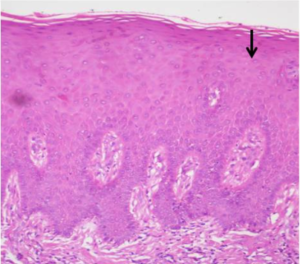
Figure 1: Para keratinization among Group I Patients (HE staining ×4).
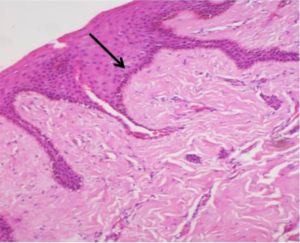
Figure 2: Epithelial dysplasia among Group I (HE staining ×10).
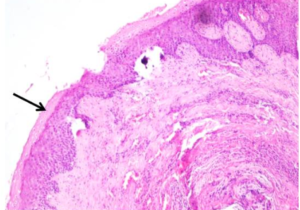
Figure 3: Increase in keratinocyte among Group I (HE staining ×10).
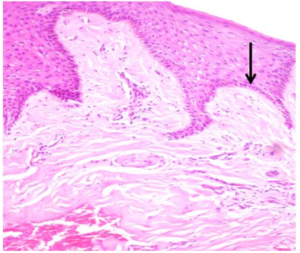
Figure 4: Increased epithelial basal cell thickness in Group II (HE staining ×4).
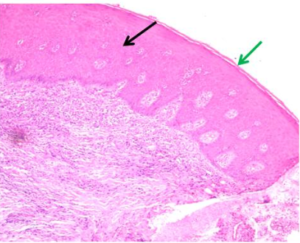
Figure 5: Acanthosis (black arrow) and keratosis (green arrow) higher among Group II (HE staining ×10).
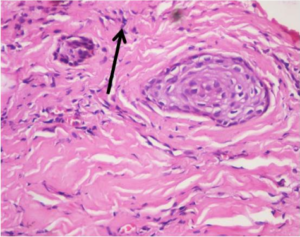
Figure 6: Increased number of fibroblast in Group II (HE staining ×4).

Figure 7: Collagen hyalinization higher among Group II (HE staining ×10).
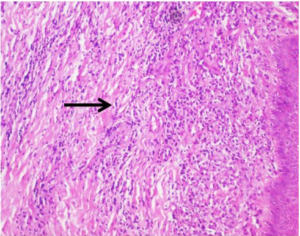
Figure 8: Increased inflammatory cell infiltrate among Group I (HE staining ×4).

Figure 9: Thick mature short collagen present in small bundles (HE staining ×4).
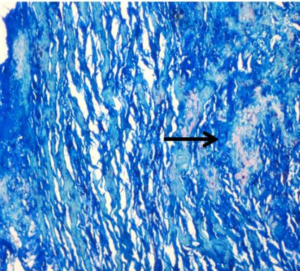
Figure 10: Thick mature short collagen present in small bundles and engorged blood vessels (Masson’s trichrome staining ×4).
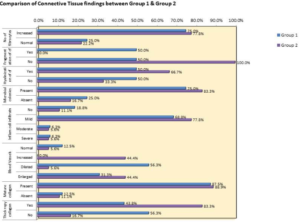
Figure 11: Graphical comparison of epithelial findings between Group 1 and Group 2.
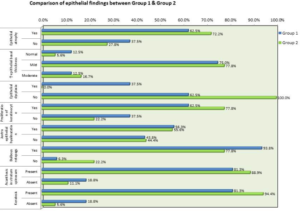
Figure 12: Graphical comparison of connective tissue findings between Group 1 and Group 2.
Discussion
It has been proven that the cigarette smoke constitutes more than 3800 chemicals, including hydrogen cyanide, carbon monoxide and oxidizing chemicals which are known to be carcinogenic for health [7]. In the Dunedin birth cohort Thompson and his co-workers have stated that the individuals who had been smoking throughout their lifetime endured worse periodontal status and also rapid progression of periodontal disease when compared to non-smokers [8]. According to Tijhof and Winkelhof, Smokers exhibited marked abundance of pathogens such as Tannerella forsythia, Fusobacterium nucleatum and Campylobacter rectus in the maxilla [9]. The greater probing depths and attachment loss occurred in the maxillary and mandibular anterior teeth suggesting the marked localized effect of smoking [10].
The deteriorating effect of smoking on periodontium is caused by greater number of periodontal pathogens, mechanical therapy possessing difficulty to eliminate the pathogens, remodelling of the vasculature, alterations of fibroblast function and attachment process, adverse effect on growth factor and cytokine production, varied neutrophil function [11].
It has been reported that the diabetes of a longer run and lower metabolic control demonstrated increased incidence of periodontal disease [12]. Moreover, it has been implicated that diabetic individuals showed higher collagenase production, malfunctioning of neutrophils and abnormal metabolic activities in periodontal fibroblast [13,14]. According to the histological research by Hove and Stallard the gingival vasculature in diabetics have higher risk for atherosclerosis than to those of non-diabetics [15].
There is insufficient research regarding the influence of smoking in diabetic subjects. According to the Korean diabetes association, termination of smoking habit is regarded as the most important step in preventing complications of heart disease [16]. Increased oxidative stress and inflammation [17]. Not only affects the beta cell function but also remodeling of endothelial cell [18,19]. In smokers the adjusted risk of diabetes is 1.4 times than the non-smoker counterparts [20]. Cigarette smoking also minimizes the uptake of insulin mediated glucose by ten to forty percent in smokers [21,22]. Insulin and C-peptide exaggerated response to oral glucose load was observed using Euglycemic technique [23]. Increased amount of white blood cells, neutrophils and monocytes are seen in smokers which lead to secretion of elastase, collagenase and free radicals, contributing to endothelial cell breakdown [24]. Increased activation of platelet is also observed in smokers [25]. A recent meta-analysis from six studies involving 2361 individuals indicated that active smokers have three times higher risk of tooth loss from periodontal diseases [26].
Our study consisted of subjects with smokers and non-smoker patients with type II diabetes and chronic periodontitis. Epithelial dysplasia was highly significant among smoker diabetic patients with chronic periodontitis Group (p<0.004). Fragmentation of collagen fibers (p<0.001) and reduced inflammatory infiltrate with increase in number of blood vessels (p<0.002) was seen in Group I patients.
Epithelial atrophy with increase in epithelial basal layer with proliferation of keratinocytes and acanthosis of stratum spinosum was significantly higher among Group II patients.
Increased blood vessel density and decreased inflammatory cell infiltration was observed in smokers [27]. The above findings were consistent with our study in which statistical increase in number of blood vessels was also observed (p<0.002). Dilations of blood vessels were observed among Group I patients, our results were contrary to the results of the study done by Sreedevi et al., Keratosis and bulbous rete pegs was observed among Group I patients, which exactly correlated to the study given by Naderi et al. [28].
Conclusion
Diabetic smokers are at higher risk for periodontal breakdown, unsatisfactory treatment and poor prognosis. Therefore these individuals should be carefully monitored during and after periodontal therapy.
References
- Tonetti MS, Jepsen S, Jin L, Otomo‐Corgel J. Impact of the global burden of periodontal diseases on health, nutrition and wellbeing of mankind: A call for global action. J Clin Periodontal. 2017;44:456-62.
- Nazir MA.Prevalence of periodontal disease, its association with systemic diseases and prevention. Int J Health Sci. 2017;11(2):72-80.
- Saini R,Saini S, Sugandha RS. Periodontal disease: The sixth complication of diabetes. J Fam Community Med. 2011;18(1):31.
- Tomar SL, Asma S. Smoking-attributable Periodontitis in the United States: findings from NHANES III. National Health and Nutrition Examination Survey. J Periodontol. 2000;71(5):743-51.
- Hyman JJ, Reid BC. Epidemiologic risk factors for periodontal attachment loss among adults in the United States. J Clin Periodontol. 2003;30(3):230-7.
- Dhir S, Kumar V. Are cardiovascular risk parameters and glycemic levels associated with periodontitis in type 2 diabetes patients? A clinical study. Indian Heart J Interv. 2018;70(3):430-2.
- Eriksen MP, LeMaistre CA, Newell GR. Health Hazards of passive smoking. Annu Rev Public Health. 1988;9(1):47-70.
- Zeng J, Williams SM, Fletcher DJ, Cameron CM, Broadbent JM, Shearer DM et al. Reexamining the association between smoking and periodontitis in the Dunedin study with an enhanced analytical approach. J Periodontal. 2014;85(10):1390-7.
- Van Winkelhoff AJ, Bosch‐Tijhof CJ, Winkel EG, Van der Reijden WA. Smoking affects the subgingival microflora in periodontitis. J Periodontol. 2001;72(5):666-71.
- Trombelli L, Cho KS, Kim CK, Scapoli C, Scabbia A. Impaired healing response of periodontal furcation defects following flap debridement surgery in smokers: A controlled clinical trial. J Clin Periodontol. 2003;30(1):81-7.
- Malhotra R,Kapoor A, Grover V, Kaushal S. Nicotine and periodontal tissues. J Indian Soc Periodontol. 2010;14(1):72-9.
- Bergstrand A, Bucht H. Electron microscopic investigations on the glomerular lesions in diabetes mellitus (diabetic glomerulosclerosis). Lab Invest J. 1957;6(4):293-300.
- Johnson PC, Brendel K, Meezan E. Human diabetic perineurial cell basement membrane thickening. Lab Invest J. 1981;44(3):265-70.
- Kronman JH, Cohen MM, Cote D,Waitzken L. Histologic and Study of Human Diabetic Gingiva. J Dent Res. 1970;49(1):177.
- Hove KA, Stallard E. Diabetes and the periodontal patient. J Periodontol. 1970;41(2):713-8.
- Herring ME, Shah SK. Periodontal disease and control of diabetes mellitus. J Am Osteopath Assoc. 2006;106(7):412-6.
- Mealey BL, Rose LF. Diabetes mellitus and inflammatory periodontal diseases. Curr Opi Endocrinol Diabetes Obesity. 2008;15(2):135-41.
- Tan WC, Tay FB, Lim LP.Diabetes as a risk factor for periodontal disease: current status and future considerations. Ann Acad Med Singapore. 2006;35(8):571-81.
- Hu FB, Manson JE, Stampfer MJ, Colditz G, Liu S, Solomon CG et al. Diet, lifestyle, and the risk of type 2 diabetes mellitus in women. N Engl J Med. 2001;345(11):790-7.
- El-Kishky M, Mahfouz SA, el-Habbak SM. An in vitro study of hydroxyproline synthesis in gingival fibroblasts in patients with juvenile diabetes. Egypt Dent J. 1986;32(1):15-27.
- Salo T. MMP-8/neutrophil collagenase mRNA may also be expressed in other cells than PMNs. J Dent Res. 1995;74:1036.
- Bagdade JD, Nielson KL, Bulger RJ. Reversible abnormalities in phagocytic function in poorly controlled diabetic patients. Am J Med Sci. 1972;263(6):451-6.
- Masubuchi T, Koyama S, Sato E, Takamizawa A, Kubo K, Sekiguchi M et al. Smoke extract stimulates lung epithelial cells to release neutrophil and monocyte chemotactic activity. The Am J Pathol. 1998;153:1903-12.
- Palmblad J.The Role of granulocytes in inflammation. Scand J Rheumatol. 1984;13(2):163-72.
- Togna AR, Latina V, Orlando R, Togna GI. Cigarette smoke inhibits adenine nucleotide hydrolysis by human platelets. Platelets. 2008;19(7):537-42.
- Novak MJ, Novak KF. Smoking and periodontal disease. Clin Periodontol. 10th St. Louis, Mo.: Saunders Elsevier, 2006.251-8.
- Sreedevi M, Ramesh A, Dwarakanath C. Periodontal status in smokers and nonsmokers: a clinical, microbiological, and histopathological study. Int J Dent. 2012;2012:1-10.
- NaderiNJ, Semyari H, Elahinia Z. The impact of smoking on gingiva: a histopathological study. Iran J Pathol. 2015;10(3):214-20.
Article Type
Research Article
Publication History
Received Date: 29-05-2020
Accepted Date: 12-06-2020
Published Date: 20-06-2020
Copyright© 2020 by Yadav E, et al. All rights reserved. This is an open access article distributed under the terms of the Creative Commons Attribution License, which permits unrestricted use, distribution, and reproduction in any medium, provided the original author and source are credited.
Citation: Yadav E, et al. Histological Effect of Smoking on Gingiva of Patients with Type II Diabetes Mellitus and Chronic Periodontitis: A Randomized Controlled Trial. J Dental Health Oral Res. 2020;1(2):1-13.

Figure 1: Para keratinization among Group I Patients (HE staining ×4).

Figure 2: Epithelial dysplasia among Group I (HE staining ×10).

Figure 3: Increase in keratinocyte among Group I (HE staining ×10).

Figure 4: Increased epithelial basal cell thickness in Group II (HE staining ×4).

Figure 5: Acanthosis (black arrow) and keratosis (green arrow) higher among Group II (HE staining ×10).

Figure 6: Increased number of fibroblast in Group II (HE staining ×4).

Figure 7: Collagen hyalinization higher among Group II (HE staining ×10).

Figure 8: Increased inflammatory cell infiltrate among Group I (HE staining ×4).

Figure 9: Thick mature short collagen present in small bundles (HE staining ×4).

Figure 10: Thick mature short collagen present in small bundles and engorged blood vessels (Masson’s trichrome staining ×4).

Figure 11: Graphical comparison of epithelial findings between Group 1 and Group 2.

Figure 12: Graphical comparison of connective tissue findings between Group 1 and Group 2.
Table 1: Consort flowchart showing the, Eligibility assessment, randomization and sample collection.
|
Comparison of epithelial findings between Group 1 and Group 2 using Chi square Test |
|||||||
|
Variables |
Category |
Group 1 |
Group 2 |
c2 Value |
P-Value |
||
|
N |
% |
n |
% |
||||
|
Epithelial atrophy |
Yes |
10 |
62.50% |
13 |
72.20% |
0.366 |
0.54 |
|
No |
6 |
37.50% |
5 |
27.80% |
|||
|
Increased epithelial basal thickness |
Normal |
2 |
12.50% |
1 |
5.60% |
0.572 |
0.75 |
|
Mild |
12 |
75.00% |
14 |
77.80% |
|||
|
Moderate |
2 |
12.50% |
3 |
16.70% |
|||
|
Epithelial dysplasia |
Yes |
6 |
37.50% |
0 |
0.00% |
8.196 |
0.004* |
|
No |
10 |
62.50% |
18 |
100.00% |
|||
|
Proliferation of keratinocyte |
Yes |
10 |
62.50% |
14 |
77.80% |
0.952 |
0.33 |
|
No |
6 |
37.50% |
4 |
22.20% |
|||
|
Juxta epithelial hyalinization |
Yes |
9 |
56.30% |
10 |
55.60% |
0.002 |
0.97 |
|
No |
7 |
43.80% |
8 |
44.40% |
|||
|
Bulbous rete pegs |
Yes |
15 |
93.80% |
14 |
77.80% |
1.723 |
0.19 |
|
No |
1 |
6.30% |
4 |
22.20% |
|||
|
Acanthosis in stratum spinosum |
Present |
13 |
81.30% |
16 |
88.90% |
0.394 |
0.53 |
|
Absent |
3 |
18.80% |
2 |
11.10% |
|||
|
Keratosis |
Present |
13 |
81.30% |
17 |
94.40% |
1.421 |
0.23 |
|
Absent |
3 |
18.80% |
1 |
5.60% |
|||
Table 2: Comparison of epithelial findings between Group 1 and Group 2. *- (P<0.001) statistically significant.
|
Comparison of Connective Tissue findings between Group 1 and Group 2 using Chi square Test |
|||||||
|
Variables |
Category |
Group 1 |
Group 2 |
c2 Value |
P-Value |
||
|
N |
% |
n |
% |
||||
|
No. of Fibrocytes |
Increased |
12 |
75.00% |
14 |
77.80% |
0.036 |
0.85 |
|
Normal |
4 |
25.00% |
4 |
22.20% |
|||
|
Fragmentation of collagen fibers |
Yes |
8 |
50.00% |
0 |
0.00% |
11.769 |
0.001* |
|
No |
8 |
50.00% |
18 |
100.00% |
|||
|
Hyalinization of collagen fibers |
Yes |
8 |
50.00% |
12 |
66.70% |
0.971 |
0.32 |
|
No |
8 |
50.00% |
6 |
33.30% |
|||
|
Microbial colonies |
Present |
12 |
75.00% |
15 |
83.30% |
0.36 |
0.55 |
|
Absent |
4 |
25.00% |
3 |
16.70% |
|||
|
Inflammatory cell infiltration |
No |
3 |
18.80% |
2 |
11.10% |
0.444 |
0.93 |
|
Mild |
11 |
68.80% |
14 |
77.80% |
|||
|
Moderate |
1 |
6.30% |
1 |
5.60% |
|||
|
Severe |
1 |
6.30% |
1 |
5.60% |
|||
|
Blood Vessels |
Normal |
2 |
12.50% |
1 |
5.60% |
15.361 |
0.002* |
|
Increased |
0 |
0.00% |
8 |
44.40% |
|||
|
Dilated |
9 |
56.30% |
1 |
5.60% |
|||
|
Enlarged |
5 |
31.30% |
8 |
44.40% |
|||
|
Mature collagen |
Present |
14 |
87.50% |
16 |
88.90% |
0.016 |
0.9 |
|
Absent |
2 |
12.50% |
2 |
11.10% |
|||
|
Thick ropy collagen |
Yes |
7 |
43.80% |
15 |
83.30% |
5.812 |
0.02* |
|
No |
9 |
56.30% |
3 |
16.70% |
|||
Table 3: Comparison of Connective Tissue findings between Group 1 and Group 2. *- (P<0.001) statistically significant.


